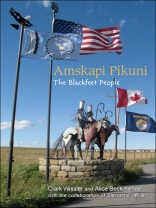A contemporary history of one of the best-known American Indian nations.
Written in collaboration with Blackfoot tribal historians and educators, Amskapi Pikuni: The Blackfeet People portrays a strong native nation fighting for two centuries against domination by Anglo invaders. The Blackfeet endured bungling, corrupt, and drunken agents; racist schoolteachers; and a federal Indian Bureau that failed to disburse millions of dollars owed to the tribe. Located on a reservation in Montana cut and cut again to give land to white ranchers, the Blackfeet adapted to complete loss of their staple food, bison-a collapse of what had been a sustainable economy throughout their history. Despite all of these challenges, the nation held to its values and continues to proudly preserve its culture.
قائمة المحتويات
List of Illustrations
Preface
Memorial to Stewart Miller, by Walter Lamar
1. Wissler’s 1933 Manuscript
2. The Amskapi Pikuni from the 1950s to 2010, by Chief Earl Old Person
3. Bungling
4. Schooling
5. The Ranchers
6. About Clark Wissler
Addendum
Notes
References
Index
عن المؤلف
Clark Wissler (1870–1947) was an American anthropologist and a specialist in North American ethnography, focusing on the Indians of the Plains. He was the first anthropologist to perceive the normative aspect of culture, to define it as learned behavior, and to describe it as a complex of ideas, all characteristics of culture that are today generally accepted. Alice Beck Kehoe is Professor Emerita of Anthropology at Marquette University. She is the author of many books, including Controversies in Archaeology; The Ghost Dance: Ethnohistory and Revitalization, Second Edition; and North American Indians: A Comprehensive Account, Third Edition. Stewart E. Miller (1950–2008) was a Blackfeet tribal member who worked at the Tribal Historic Preservation Office. He collaborated with Kehoe, providing much of the research material and ensuring that the text reflected Blackfoot culture correctly, until he passed away suddenly in 2008.












